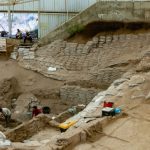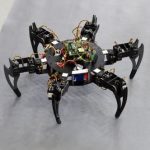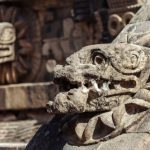 History
History  History
History  Pop Culture
Pop Culture 10 Cases of Grabbing Defeat from the Jaws of Victory
 History
History 10 Common Misconceptions About the Renaissance
 Weird Stuff
Weird Stuff 10 Crazy Things Resulting from Hidden Contract Provisions
 Facts
Facts 10 Unusual Facts About Calories
 Weird Stuff
Weird Stuff 10 Days of Humiliation When the Person Should Have Stayed in Bed
 Humans
Humans 10 Surprising Ways Game Theory Rules Your Daily Life
 Food
Food 10 Popular (and Weird) Ancient Foods
 Animals
Animals Ten Bizarre Creatures from Beneath the Waves
 Technology
Technology 10 Unexpected Things Scientists Made Using DNA
 History
History 10 Events That Unexpectedly Changed American Life
 Pop Culture
Pop Culture 10 Cases of Grabbing Defeat from the Jaws of Victory
 History
History 10 Common Misconceptions About the Renaissance
Who's Behind Listverse?

Jamie Frater
Head Editor
Jamie founded Listverse due to an insatiable desire to share fascinating, obscure, and bizarre facts. He has been a guest speaker on numerous national radio and television stations and is a five time published author.
More About Us Weird Stuff
Weird Stuff 10 Crazy Things Resulting from Hidden Contract Provisions
 Facts
Facts 10 Unusual Facts About Calories
 Weird Stuff
Weird Stuff 10 Days of Humiliation When the Person Should Have Stayed in Bed
 Humans
Humans 10 Surprising Ways Game Theory Rules Your Daily Life
 Food
Food 10 Popular (and Weird) Ancient Foods
 Animals
Animals Ten Bizarre Creatures from Beneath the Waves
 Technology
Technology 10 Unexpected Things Scientists Made Using DNA
10 Ancient “Smart” Materials Scientists Still Can’t Reproduce
As civilizations from Rome to the Maya harnessed empirical ingenuity to create materials with built-in healing, color-shifting, or structural resilience, they left behind recipes that modern science is only now decoding. From rust-proof iron pillars and self-repairing concrete to nanotech-level glass and ancient vulcanized rubber, these ten remarkable “smart” materials demonstrate how our ancestors engineered solutions that still inspire today’s cutting-edge research.
Related: 10 Surprising Secrets of Ancient Medieval Fortresses
10 Roman Self-Healing Concrete
The secret behind the longevity of Roman maritime structures lies in a precise combination of volcanic ash (pozzolana), lime, and seawater, creating a hydraulic binder that sets underwater. When tiny fissures form, they allow seawater to infiltrate the mortar, dissolving calcium hydroxide and unreacted lime particles. These dissolved minerals then react with silica and alumina from the volcanic ash to precipitate aluminum tobermorite crystals within the cracks. Detailed petrographic analyses of cores taken from the Roman piers at Pozzuoli Bay have revealed layers of tobermorite up to 150 micrometers thick, effectively sealing cracks over decades. Modern X-ray diffraction and scanning electron microscopy studies confirm that this autogenous healing process continues long after initial curing.
Researchers at MIT’s Department of Civil and Environmental Engineering and the University of Toronto’s Department of Materials Science are reproducing this mechanism by embedding ureolytic bacteria (Sporosarcina pasteurii) or encapsulated mineral precursors (calcium lactate microcapsules) into contemporary concrete mixes. When microcracks allow water ingress, the bacteria hydrolyze urea to produce carbonate ions, which combine with calcium to form calcite, sealing fissures up to 0.5 mm wide. Large-scale field trials on highway bridges are underway to quantify long-term durability improvements and to compare the energy footprint of biologically active concrete versus traditional repair cycles.[1]
9 Wootz (Damascus) Steel
Originating in South India as early as the 3rd century BCE, Wootz steel was traded globally and forged into the legendary Damascus blades admired for their combination of razor-sharp edges and exceptional toughness. Chemical analysis of surviving Wootz ingots and blades—using transmission electron microscopy and atom probe tomography—has identified networks of carbide nanoparticles enriched in vanadium and molybdenum at grain boundaries, which impede crack propagation. Periodic thermal cycling and repeated folding during forging created a banded microstructure: alternating layers of hard cementite and softer ferrite phases.
Contemporary metallurgists at the University of Manchester’s Henry Royce Institute and Tohoku University’s Institute for Materials Research are exploring powder metallurgy and laser additive manufacturing techniques to recreate these features. By controlling cooling rates to within 1 °C per second and introducing trace vanadium at concentrations as low as 0.03%, they have produced experimental blades exhibiting hardness values above 65 HRC and Charpy impact toughness comparable to historical artifacts. Collaborations with archaeometallurgists are refining thermal-tempering schedules based on differential scanning calorimetry data from authenticated Wootz samples.[2]
8 The Lycurgus Cup’s Dichroic Glass
Crafted in the 4th century CE, the Lycurgus Cup remains an unparalleled example of ancient nanotechnology. The goblet’s silica matrix contains embedded gold and silver nanoparticles, typically 15–25 nanometers in diameter, that interact with visible light via localized surface plasmon resonance. In reflected light, shorter wavelengths are predominantly scattered, giving the cup a jade-green appearance; in transmitted light, longer red wavelengths pass through, rendering a translucent ruby-red hue. Synchrotron-based X-ray absorption spectroscopy has precisely mapped the ratio of gold to silver, revealing 5:1 proportions concentrated near the inner surface where nanoparticle density is highest.
Current efforts in photonic materials research at Harvard SEAS involve synthesizing sol-gel glass matrices with tunable metal-nanoparticle distributions. By adjusting reduction potentials during chemical vapor deposition, engineers achieve narrow particle-size distributions within 1–2 nanometers variance. These advanced dichroic films are being tested as anti-counterfeiting overlays for currency and corporate securities. Larger-scale fabrication trials are also exploring dynamic window coatings that adaptively alter color balance in response to sunlight intensity, potentially reducing building cooling loads by up to 12%.[3]
7 Egyptian Faience
Egyptian faience—far older than glazed ceramics—relies on a quartz (silica) core mixed with alkali fluxes (natron or plant ash) and copper-based colorants. During firing at temperatures between 1,472°F and 1,742°F (800°C and 950°C), a thin layer of the surface liquefies, forming a self-glazed vitreous coating rich in copper silicates that produce characteristic turquoise and deep blue hues. Microprobe analysis of artifacts from Abydos shows copper concentrations of 4–7% by weight in the glaze layer, with an interfacial transition zone where silica gradually increases from 60% to over 80%. Controlled-atmosphere kilns recreated in lab settings demonstrate that minor variations in oxygen partial pressure (from 0.01 to 0.03 atm) significantly shift glaze opacity and color saturation.
Chemists at the Getty Conservation Institute are using laser-induced breakdown spectroscopy to monitor in-situ glaze formation and to identify optimal firing profiles that minimize kiln defects. Their goal is to develop environmentally friendly flux alternatives—such as sodium-potassium borates—reducing reliance on mined natron. Additionally, exploring microscale layering techniques has led to prototype tiles with graded color zones, replicating ancient faience’s natural gradient effects for modern architectural and artistic applications.[4]
6 Maya Blue Pigment
Celebrated for its vibrancy and resilience in tropical conditions, Maya Blue results from indigo molecules encapsulated in the channel structure of palygorskite clay. When mixtures of finely ground indigofera leaves and palygorskite are heated to 248–302°F (120–150°C) for 1–2 hours, indigo bonds via hydrogen and van der Waals interactions to silanol groups lining the clay’s tubular channels. Synchrotron X-ray diffraction studies reveal that approximately 0.7 molecules of indigo occupy each unit cell of palygorskite, creating a hybrid organic–inorganic pigment that resists acids, alkalis, and microbial degradation.
At UCSB’s Materials Research Laboratory and UNAM’s Institute of Materials Research, scientists employ infrared spectroscopy and thermogravimetric analysis to optimize low-temperature binding protocols that prevent indigo decomposition. Their work has yielded synthetic Maya Blue variants incorporating other natural dyes—such as carmine and weld—to produce a spectrum of durable pigments for conservation-grade paints and inks. Ongoing field tests on historical building facades in Mexico are evaluating weathering performance over multi-year exposures to UV radiation and acid rain.[5]
5 The Iron Pillar of Delhi
Erected around AD 400 in the temple complex of Qutub Minar, the 23-foot (7-meter) tall, 6-ton Iron Pillar of Delhi remains remarkably rust-free despite exposure to monsoon rains. The artifact’s purity—iron content exceeding 98%, phosphorus levels around 0.25–0.30%, and negligible sulfur or manganese—encouraged formation of a passive oxide film. Analytical studies using X-ray photoelectron spectroscopy have identified a 10–15 µm thick misawite (δ-FeOOH) layer that adheres tightly to the metal, preventing oxygen infiltration and further corrosion.
Materials scientists at the Indian Institute of Science and the National Physical Laboratory in India replicate this ancient alloy via bloomery-smelting processes, adjusting bog iron feedstock phosphorus content. Their accelerated weathering tests—subjecting replicas to cyclic salt-spray and humidity conditions—demonstrate corrosion rates less than 0.01 mm/year, outperforming comparable modern steels in marine environments. These findings inform development of low-alloy, high-phosphorus steels for coastal infrastructure that mimic the Iron Pillar’s self-protective characteristics.[6]
4 Chinese Imperial Porcelain
By the Tang Dynasty (7th–10th centuries AD) and reaching zenith under Song and Ming rule, Chinese kilns in Jingdezhen produced porcelain so pure that it transmitted light when thinly cast and rang like a bell when tapped. The body comprised 70–75% kaolin clay for plasticity and 25–30% petuntse (feldspathic rock) for vitrification, fired at temperatures exceeding 2,372°F (1,300 °C) in oxidizing atmospheres. Laser-induced breakdown spectroscopy and electron microprobe analyses of shard cross-sections reveal uniform grain sizes below 2 µm and minimal microcracking, contributing to translucency and mechanical strength.
Modern ceramists at the Imperial Kiln Museum and Tsinghua University apply programmable electric kilns with precise ramp rates (up to 50°F or 10 °C/min) to replicate Ming-era glazes containing trace manganese and iron impurities. Their work has led to advanced zirconia-reinforced porcelain composites with fracture toughness values above 4 MPa·m½ and thermal shock resistance suitable for aerospace components. Additionally, insights into ancient firing–cooling profiles guide the manufacture of orthopaedic implants with bioinert surfaces and tailored porosity.[7]
3 Mesoamerican Vulcanized Rubber
Long before Goodyear’s 19th-century breakthrough, the Olmecs and Maya mixed latex from Castilla elastica trees with sap from morning-glory vines (Ipomoea alba), whose organic sulfur compounds initiated cross-linking. Gas chromatography–mass spectrometry of ceremonial ball fragments reveals sulfurated organic moieties at 1–2% wt, sufficient to create covalent C–S bonds between polyisoprene chains. This primitive vulcanization enhanced elasticity and thermal stability, maintaining mechanical integrity across 68–104°F (20–40°C) diurnal swings.
Researchers at the University of Akron’s Polymer Science Center are reverse-engineering these ancient recipes, using thermogravimetric analysis to map curing kinetics and dynamic mechanical analysis to measure storage—and loss moduli—over frequency sweeps. Their bio-based elastomer prototypes incorporate plant-derived sulfur donors and natural antioxidants, exhibiting tensile strengths above 15 MPa and self-healing properties when reheated to 140°F (60°C). Applications include eco-friendly gaskets and seals for green energy systems.[8]
2 Inca Seismic-Proof Stone Masonry
At sites such as Sacsayhuamán and Machu Picchu, Inca stonemasons carved granite and andesite blocks with convex faces and interlocking joints, achieving assembly tolerances under 1–2 mm. Finite-element modeling of wall segments shows that under simulated 7.5-magnitude earthquakes, blocks pivot and settle laterally by up to 3 mm, dissipating seismic energy without structural failure. Surface polishing techniques removed microasperities, ensuring even contact pressure and eliminating stress concentrators.
Engineers at the University of Cambridge’s Centre for Smart Infrastructure and Rensselaer Polytechnic Institute use laser scanning and photogrammetry to capture joint geometries, then employ robotic milling to fabricate modern analogues in high-strength concrete. Integrating fiber-optic strain sensors within joints, prototypes demonstrate self-centering behavior and maintain vertical alignment after thousands of cyclic load tests—validating the Incas’ millennia-old earthquake-resilient design.[9]
1 Greek Fire’s Seaworthy Adhesive Mixture
While renowned as a naval incendiary, Greek Fire also functioned as a hydrocarbon-based sealant that adhered to wet timber hulls. Byzantine texts suggest a blend of pine resin, naphtha, quicklime, sulfur, and pitch. Experimental reenactments at Aristotle University of Thessaloniki using period-accurate pine resin ratios (30–40% wt) and purified bitumen show exothermic polymerization when mixed with lime water, forming a cross-linked matrix that maintains adhesion after a 72-hour saltwater immersion.
Contemporary chemists analyze these formulations using differential scanning calorimetry to map exotherm peaks and rheometry to assess viscosity changes under shear. Guided by these insights, polymer engineers are developing bio-inspired marine coatings with dual adhesive and hydrophobic properties, achieving pull-off adhesion strengths above 2 MPa and water contact angles exceeding 120°, without relying on toxic antifouling agents.[10]








